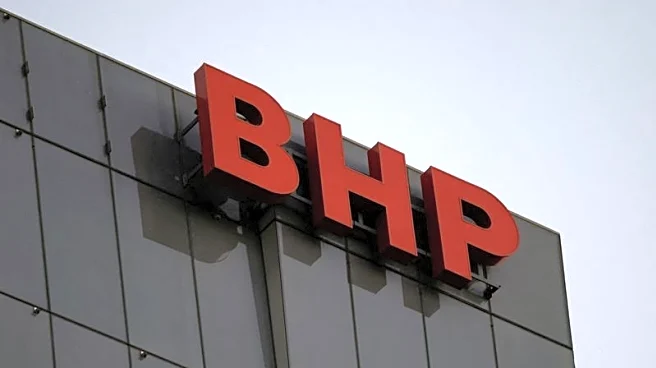What's Happening?
BHP, the world's largest listed mining company, has expressed optimism about global iron ore demand despite a slowdown in Chinese economic growth. According to CEO Mike Henry, macro-economic signals for
commodity demand remain resilient, with global growth forecasts improving. This comes as BHP reported first-quarter iron ore production slightly below expectations due to maintenance activities at Port Hedland. The company produced 70.2 million tons of iron ore from its Western Australian operations, just under the expected 71.55 million tons. Despite this, BHP increased its higher-value lump iron ore sales by five percent and maintained its fiscal 2026 output guidance. Additionally, BHP's copper production rose by four percent, and the company is advancing its investment in copper due to its importance in renewable energy transitions. The Jansen potash project in Canada is also progressing well, with Stage 1 on track for 2027 production.
Why It's Important?
BHP's positive outlook is significant as it suggests resilience in the global commodity market despite economic challenges in China, a major consumer of raw materials. The company's ability to maintain production guidance and increase sales of higher-value products indicates strong demand and strategic positioning. BHP's focus on copper investment aligns with the growing importance of the metal in renewable energy, potentially positioning the company as a key player in the energy transition. The progress in the Jansen potash project further diversifies BHP's portfolio, potentially enhancing its long-term growth prospects. These developments could have broader implications for the mining industry and global supply chains, influencing market dynamics and investment strategies.
What's Next?
BHP's continued investment in copper and potash projects suggests a strategic focus on diversifying its portfolio and capitalizing on emerging market trends. The completion of maintenance at Port Hedland and the ongoing progress in the Jansen project are likely to support BHP's production targets. Stakeholders, including investors and industry analysts, will be closely monitoring BHP's performance and market conditions, particularly in China, to assess future demand and pricing trends. The company's ability to navigate these challenges and leverage its strategic investments will be crucial in maintaining its market position.
Beyond the Headlines
BHP's strategic investments in copper and potash highlight a broader industry trend towards diversification and sustainability. As the demand for renewable energy resources grows, companies like BHP are positioning themselves to benefit from the transition. This shift may lead to increased competition and innovation in the mining sector, with potential regulatory and environmental implications. The focus on sustainable practices and resource management could also influence public perception and corporate responsibility initiatives, shaping the future of the industry.












